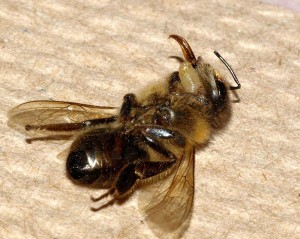Mary at USA Live Bee Removal specializes in live honeybee removal without the use of chemicals. Mary has provided live bee removal service in all San Bernardino, Riverside County at reasonable rates, hire a professional who will do the job right at USA Live Bee Removal and save bees!
Enjoy our new article:
Humans are spreading a virus killing millions of bees
University of California, Berkeley, University of Sheffield
rightOriginal Study; Posted by Sean Barton-Sheffield on February 5, 2016
European honey bees appear to be the source of a disease that is affecting bee hives worldwide, a new study shows. And human activity, particularly moving bees from place to place to pollinate crops, is spreading the disease, called deformed wing virus.

“We must now maintain strict limits on the movement of bees, whether they are known to carry Varroa or not.”
The virus is particularly deadly when the parasitic Varroa mite carries it. The combination has wiped out millions of honey bees over recent decades, researchers say.
Varroa feed on bee larvae and the deformed wing virus kills off bees—a devastating double blow to colonies that is adding to fears about global bee populations, with implications for biodiversity, agricultural biosecurity, global economies, and human health.
“The deformed wing virus is a major threat to honey bee populations across the world, and our study has found that this epidemic has been driven by the trade and movement of honey bee colonies,” says Roger Butlin, professor of evolutionary biology at the University of Sheffield.
“Domesticated honey bee colonies are hugely important for our agriculture systems, but this study shows the risks of moving animals and plants around the world. The consequences can be devastating, both for domestic animals and for wildlife. The risk of introducing viruses or other pathogens is just one of many potential dangers.”
[Mites fool honeybees with chemical ‘cologne’]
“This is the first study to conclude that Europe is the backbone of the global spread of the bee-killing combination of deformed wing virus and Varroa,” says Lena Wilfert from the University of Exeter’s Centre for Ecology and Conservation.
“This demonstrates that the spread of this combination is largely manmade—if the spread was naturally occurring, we would expect to see transmission between countries that are close to each other, but we found that, for example, the New Zealand virus population originated in Europe. This significantly strengthens the theory that human transportation of bees is responsible for the spread of this devastating disease.
“We must now maintain strict limits on the movement of bees, whether they are known to carry Varroa or not. It’s also really important that beekeepers at all levels take steps to control Varroa in their hives, as this viral disease can also affect wild pollinators.”
For the study, published in the journal Science, researchers analyzed sequence data of deformed wing virus samples across the globe from honey bees and Varroa mites, as well as the occurrence of Varroa. They used the information to reconstruct the spread of deformed wing virus and found that the epidemic largely spread from Europe to North America, Australia, and New Zealand.
[Claims about crops won’t save wild bees]
The findings suggest some two-way movement between Europe and Asia, but none between Asia and Australasia, despite their closer proximity. The team also looked at samples from other species suspected of transmitting the disease, including different species of honey bee, mite, and bumblebees, but concluded that the European honey bee was the key transmitter.
“The key insight of our work is that the global virus pandemic in honey bees is manmade not natural,” says senior author Mike Boots, a professor at the University of California, Berkeley, and the University of Exeter. “It’s therefore within our hands to mitigate this and future disease problems.”
The Natural Environment Research Council funded the work. Researchers from ETH Zurich, the University of Cambridge, and the University of Salford collaborated on the study.
Need a Quote? you will get a response in few minutes.
[wpseo_address id=”843″ show_state=”1″ show_country=”1″ show_phone=”1″ show_phone_2=”1″ show_fax=”1″ show_email=”1″ show_logo=”0″]

